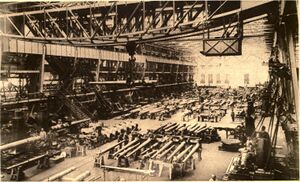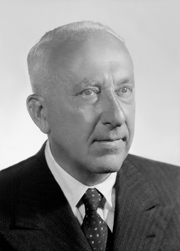Labour and Unionists Cooperative
Labour and Unionists Cooperative Ocisa e Uninui Cooperative | |
|---|---|
 | |
| Abbreviation | OeUC |
| Chairperson | Nicolas Jessen |
| Vice-Chairperson | Dhreja Schi |
| Founded | March 22, 1919 (as the SLLUC) |
| Legalised | July 11, 1942 |
| Youth wing | Young Labour |
| Ideology | Democratic Socialism Anti-Capitalism |
| Political position | Left wing to Far left |
| Colors | Red |
| Commons Council | 17 / 293
|
| State Council | 10 / 106
|
| State Governors | 0 / 7
|
| State Legislatures | 26 / 487
|
 |
|---|
| This article is part of a series on the politics and government of Seketan |
As one of the original political organizations in Seketan, the Labour and Unionist Cooperative (Seketese: Ocisa e Uninui Cooperative, OeUC), or more often just shortened to Labour, is a left-wing political party in Seketan. It originated as a loose alliance of various workers unions and communist groups during the Nelbec Empire. Upon dissolution of the imperial crown, Seketan descended into political chaos, with a civil war breaking out between the Far-Left Soysmets and the Republicans, led by the Kjedorate . Labour sided with the republic, but once the war concluded, were banned and had their ranks cracked down in by the general anti-communist sentiment of the Early Republic. It wasn’t until WWII, when Seketan needed to gain favour with the USSR for supplies, that the party was finally allowed to participate in elections.
For most of the 1940’s to the 1970’s it was the dominant left wing party, being the token opposition to the authoriarian Kjedorate party. It's main role was to represent labour unions in the Hervenskyn and to the government. During the 1978 Seketese Revoltuion the party largely sided with the Kjedorates as to hold onto the power they had, however they lost control on much of the unions as the revolution went on due to massive oppostion to the authoritaian way of life. The party would go on to lose most of their support to the Socialist Party during the nations first open and free election, holding on to only a few seats until a resurgence in the late 1990's.
Today, the party is left wing, democratic socialist yet more traditionalist than their other left-leaning counterparts like the Green Party and the Socialists. Their voter base is largely found in old coal and iron mining towns, Trjebian speaking towns, along with the poorer neighborhoods of Conelibek and Fyedor. Voters also tend to be slightly older than the Socialists, more sceptical of the EU and more opposed to changing social tides, although the party has tried to change this culture within their members. Their current leader is Nicolas Jessen, who served as Minister of Labour in 2014.
History
Early years
The creation of the OeUC came about during the rise of other left wing movements in Europe in the mist of WWI. The authoritarian and monarchist Nelbec Empire didn't allow elections or political parties, so it started as more of a nation wide workers union under the name of Seketese Workers, Labourers and Unionist Cooperative or SLLUC. The loose group were often cracked down upon by imperial police due to their anti-war positions, which often included promoting mutinies in the ranks of the army. The organization found support quickly among those working in war time factories as imperial work standards dropped in response to a greater need for materials. While forming workers unions was illegal during this time, many factory workers found a way around it by joining the SLLUC as it wasn't technically a union and thus wasn't outright illegal. Despite pressure from authorities, the SLLUC would continue to grow in numbers up until the wars end.
During the civil war
In 1919,upon the collapse of the Nelbec Empire the SLLUC formally changed its name to the Labour and Unionist Cooperative, forming the modern political organization. In the chaos of the end of the Empire, civil war broke out in Seketan, between the socialist Sosyments and the Republican Kjedorates. In 1921 the OeUC formally voted to side with the Republic and fought alongside the new Seketese Republican Army until 1923 with the war concluding in Republican victory. Initially the OeUC thought that their war time allies, the Kjedorate Party, would keep their promises to hold free and fair elections. However come 1924 the new government was formed with the Kjedorates seeming less willing to adopt a democratic system. Protests against this authoritarian move rose up, leading to the Kjedorates to require all parties to pass a "Republican value test" before being allowed to run in elections. This gave them all the power to decided who can challenge them in elections, and it lead to the banning of many political parties. Only two, including the OeUC, remained legalized due to their support amongst some section of Seketan. For the OeUC, it was their support amongst the working-class and previous support during the civil war that led to them surviving.
Under the Third Republic
Despite being legalized and allowed to run in elections, the Kjedorates still held a monopoly on power. In several elections with questionable transparency, Lorin Allis was able to maintain a super-majority of seats in the Hérvynsken and faced minimal opposition. Under the leadership of Tymoþe Jorgi, the party initiated many protests against the government, pushing for labour rights, free and open democratic elections and media freedoms. Jorgi himself was arrested a number of times for leading these protests and was barred from holding public office from 1952-1967. Jorgi would lead the party until his death in 1975 from a suspicious heart attack.
Upon the death of Jorgi, the party scrambled to find new leadership. Because Jorgi had led the party for nearly 20 years, many of the party offices were linked directly to him. After months of searching and a subsequent election, Mical Jennen became leader. Jennen began almost immediately changing the party to be more in line with the governing Kjedorates, much to the party memberships anger. When protests broke out again in 1978, the Labour party firmly planted themselves against the protesters and sided with the Kjedorates. This led to many members, particularly from the moderate and urban wing of the party, to break away and form the Socialist Democratic Movement. Despite their support for the government, the protests turned into the 1978 Seketese Revolution, which lead into the collapse of the Kjedorate government and the opening up of free and fair elections.
The Forth Republic and Today
Due to the party siding with the government in 1978, their first election resulted in a poor showing for Labour. The Socialist Party, having been the main left-wing vessel for the revolution dominated the election, leaving labour with only a small rump caucus. Over the next few elections the party was able to find a voter base that they could reliably count of for voting, largely working people in Seketan's many miner towns, along with Trjebians in South Bynan.
Leadership
| Role | Leader | Portrait | Term | Seat |
|---|---|---|---|---|
| Chairman | Nicolas Jessen | January 22, 2019-Present | Gjenor List | |
| Vice Chairwoman | Dhreja Schi | October 10, 2018-Present | Conelibek Southwest |
Electoral history
Pre revolution
Post revolition
| Election | Party votes | Total % | Change % | Seats won | Seats change | Status |
|---|---|---|---|---|---|---|
| 1978 | 156,367 | 4.8% | 6 / 193
|
Opposition | ||
| 1980 | 100,436 | 3.0% | 3 / 193
|
Opposition | ||
| 1984 | 115,054 | 4.3% | 4 / 193
|
Opposition | ||
| 1988 | 213,174 | 7.1% | 8 / 193
|
Opposition | ||
| 1992 | 220,173 | 7.5% | 9 / 193
|
Opposition | ||
| 1996 | 290,476 | 9.2% | 14 / 193
|
Opposition | ||
| 2017 | 862,517 | 17.3% | 35 / 293
|
Junior Party in Coaltion | ||
| 2021 | 243,810 | 7.4% | 15 / 293
|
Opposition |
| History | |||||||||
|---|---|---|---|---|---|---|---|---|---|
| States |
| ||||||||
| Government |
| ||||||||
| Politics |
| ||||||||
| Geography |
| ||||||||
| Economy | |||||||||
| Society | |||||||||
| Demographics |
| ||||||||
| Culture |
| ||||||||
| Symbols | |||||||||


